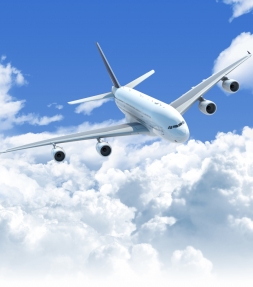

Imperial launches major green aviation research initiative and industry forum - <em>News</em>
Thursday 6 January 2011
by Colin Smith
Developing the next generation of fuel efficient, low emission aircraft will be the focus of a new research network launched today at a green aviation symposium at Imperial College London.
Emissions from the aviation industry currently account for around 3% of global warming, while air travel is expected to increase by approximately 5% per year over the next 20 years. To address these issues, the aviation industry in Europe has agreed to a set of targets that would reduce fuel and carbon dioxide emissions by 50% per passenger kilometre, nitrous oxide emissions by 80%, and noise pollution by 50%.
Imperial’s new Green Aviation Forum will draw together aerospace research from across the College, acting as a conduit for new collaborations between Imperial and the aviation industry. The symposium will provide an opportunity for Imperial academics to discuss the global challenges that the aviation industry faces and how these can be overcome with manufacturers, climate scientists, regulators, airline operators, airport authorities and the government.
Professor Ferri Aliabadi, Head of the Department of Aeronautics, said: “At Imperial, we are working with our partners towards a new generation of ultra light commercial passenger aircraft that can fly faster over longer distances, producing lower emissions and less noise. A greener, more sustainable aviation industry is possible, but it requires industry, academia, regulators and governments to work together. Our new forum and symposium will provide a useful platform for everyone to come together, thrash out the issues, and start working on innovative solutions to the challenges that we face.”

Researchers are developing new materials that will make planes lighter and stronger, to save energy costs and make planes more 'green'.
Green sky thinking
From quieter planes to latest in aircraft design, scientists at the College are already working in multidisciplinary groups on a range of initiatives to make air travel more sustainable:
Quieter runways
When planes land on a runway, spoilers, which are flaps on the wings, rise to slow down the plane. However, they also produce low frequency noise pollution. This is a major problem for the aviation industry, which is striving to reduce noise pollution in the areas surrounding airports. Professor Christos Vassilicos and his team, from the Department of Aeronautics, are designing new types of spoilers that create a high frequency sound when a plane comes into land, dissipating the low frequency sound and neutralising the noise pollution.
More fuel-efficient planes
A key factor that causes an aircraft to burn more fuel and produce greater emissions is an aerodynamic force called drag. Professor Jonathan Morrison and his colleagues from the Department of Chemical Engineering and Chemical Technology are developing a new electro-active plastic for covering aircraft fuselages and wings that can reduce drag by pulsing low-level electrical currents through it. The pulses distort the plastic and therefore the air flowing over the plane, reducing the impact of drag and thereby improving fuel consumption and reducing emissions.
Better aircraft designs
Dr Varnavas Serghides from the Department of Aeronautics is developing a range of advanced designs for more environmentally friendly and fuel-efficient aircraft that he hopes will feed into the development of new commercial aircraft in the future. Current aeroplane configurations are reaching their limit, says Dr Serghides, meaning that new incremental improvements to plane design may be unprofitable for manufacturers to implement.
Dr Serghides believes that reducing the number of aircraft components could bring dramatic new efficiencies. One of his designs is for an ‘ultra-high capacity airliner’, where the aircraft’s wings also do the job of the tail surfaces that keep the plane stable in the air. Reducing the number of parts and giving the plane a streamlined body makes the plane lighter, creating less drag and improving fuel efficiency.
The ultra-high capacity airliner also has three passenger cabins fused together to form one extra wide fuselage, fitting up to 800 passengers. This makes each flight more profitable for airlines, and reduces emissions because fewer flights are made. Fitting more passengers in horizontally, instead of vertically, also means that aircraft are no taller than conventional planes, which means that airports do not need to spend money on restructuring.
Greener aircraft structures
Researchers are also developing new types of composite materials that can be used to make aircraft stronger, lighter and more fuel-efficient. Composite materials are made from carbon fibres and resin, and they are already used in the latest passenger aircraft including the Dreamliner, manufactured by Boeing.
Imperial researchers are developing new advanced types of a composite material that can be used by manufacturers to make aircraft structures even stronger and more durable. The material is called a hierarchical composite and it comprises carbon fibres, resin and carbon nanotubes.
In addition to its environmental benefits, this material can also withstand lightning strikes, a big problem associated with flying, by dissipating the electrical energy from a lightning strike before damage is done to aircraft systems.
This research is being carried out by Dr Emile Greenhalgh , from the Department of Aeronautics, Professor Milo Shaffer , from the Departments of Chemistry, and Professor Alexander Bismarck , from the Department of Chemical Engineering and Chemical Technology. For further information about the Green Aviation Forum, visit Imperial’s website at: www.imperial.ac.uk/greenaviation
-ends-
Article text (excluding photos or graphics) available under an Attribution-NonCommercial-ShareAlike Creative Commons license.
Photos and graphics subject to third party copyright used with permission or © Imperial College London.





